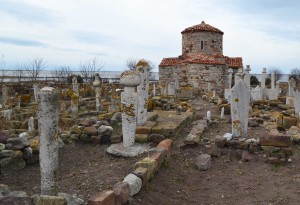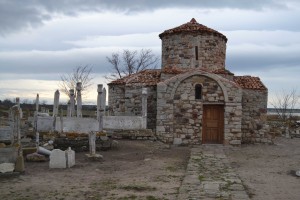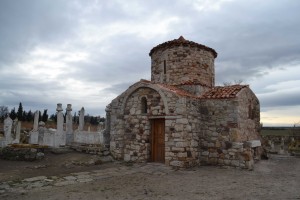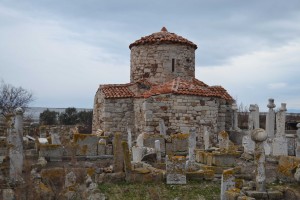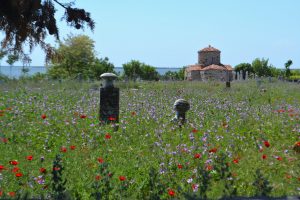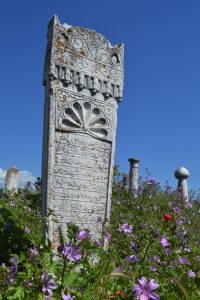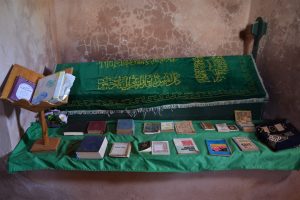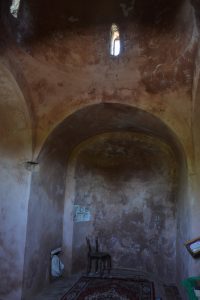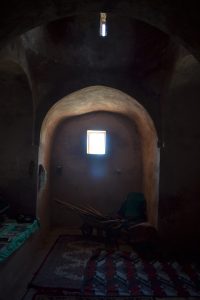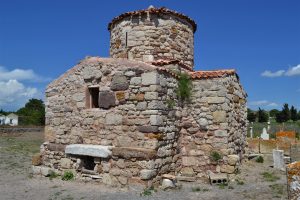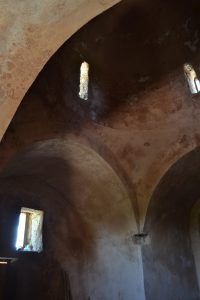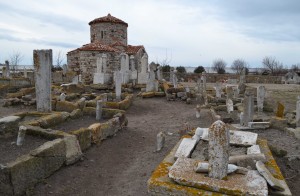Archive for February 14th, 2016
As one drives south along the lake shore from Enez Kalesi, one sees a perfect late Byzantine chapel. This is not such an unusual event in parts of Greece but since 1922, such sights have been rare in Turkey. This lovely little building owes its existence to the Ottoman conquest of Ainos in 1456. The commander of the invading fleet, Has Yunus Bey, was to be honoured with a türbe (tomb or mausoleum) on his death. The existing funerary chapel provided a convenient, ready-made solution to an empire with other things on its mind and a dignitary to bury. The chapel suffered a few non-Christian alterations but had regular maintenance and, because it was no longer a church, escaped the fate of most of the Greek churches in Turkey during the War of Independence.
One enters the Ottoman cemetery from the northern side. An exuberant crowd of people inhabits the shelter near the entrance. There is a doorway on the north side of the building, clearly not the entrance intended by the architect. The chapel is of typical form: original entry from the west, single apse to the east and with north and south arms of the cross shorter than those on the main axis. It is a tiny building, no more than eight metres long. With the rough stone walls being over half a metre thick, this leaves very little space inside. The single nave is only two metres wide and the tomb of Yunus Baba nestles snugly within the south arm of the chapel.
There has been some discussion regarding the age of the building. Eyice noted some similarities in plan to the 5th Century Mausoleum of Galla Placidia in Ravenna but reluctantly concluded that the chapel at Enez dated from close to the end of Byzantine occupation – probably the 13th century. Whoever originally suggested the chapel’s dedication to the saint named Evplos or Euplos has not recorded their reasoning in any form we can now interpret. In the absence of any evidence, the sign outside still announces this lovely little edifice as Hagios Euplos Chapel.
In May, 2017, the chapel was looking lovely in a sea of wildflowers.
The gecekondu at the entrance to the cemetery has gone and the site looks a little cleaner.
The door on the northern side was unlocked and the chapel provided a cool escape on a hot day.
The body of the admiral rests beneath an embroidered green cloth in the south arm of the chapel’s cross. Plenty of reading material is provided.
The interior is very plain and gives little hint of the ornamentation usual in a late Byzantine church. It is possible that some artistic treasures lurk beneath the plaster.
The interior of the western end shows little evidence of the original entrance. The stonework on the outside gives some clues of how the building was changed to suit its new function as a turbe.
The present entrance on the northern side is an inconspicuous side door.
Eyice, S. (1963) Enez’de Yunus Kaptan Türbesi ve Has Yunus Bey Mezarı Hakkında bir Araştırma. Tarih Dergisi. Cilt 13, Sayı 17 – 18. Available online at http://www.journals.istanbul.edu.tr/iutarih/article/view/1023002214/1023001851 Accessed 13th Feb 2016
Ousterhout, R. and C. Bakirtzis (2007) The Byzantine Monuments of the Evros/Meriç Valley. European Centre for Byzantine and Post-Byzantine Monuments. Thessaloniki. Available online at http://issuu.com/ekbmm.gr/docs/evros_meric Accessed 14th Jan 2016

